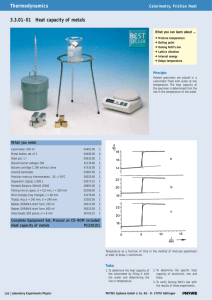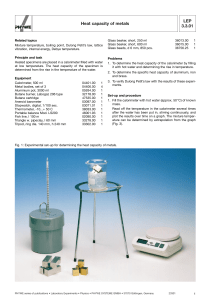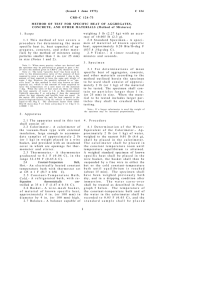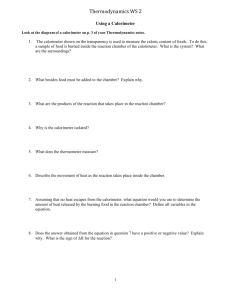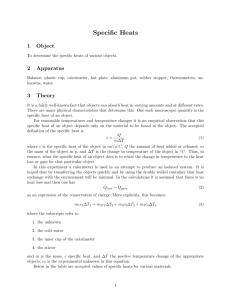Specific heat capacity 1 When a block of metal of mass 0.11 kg and
advertisement
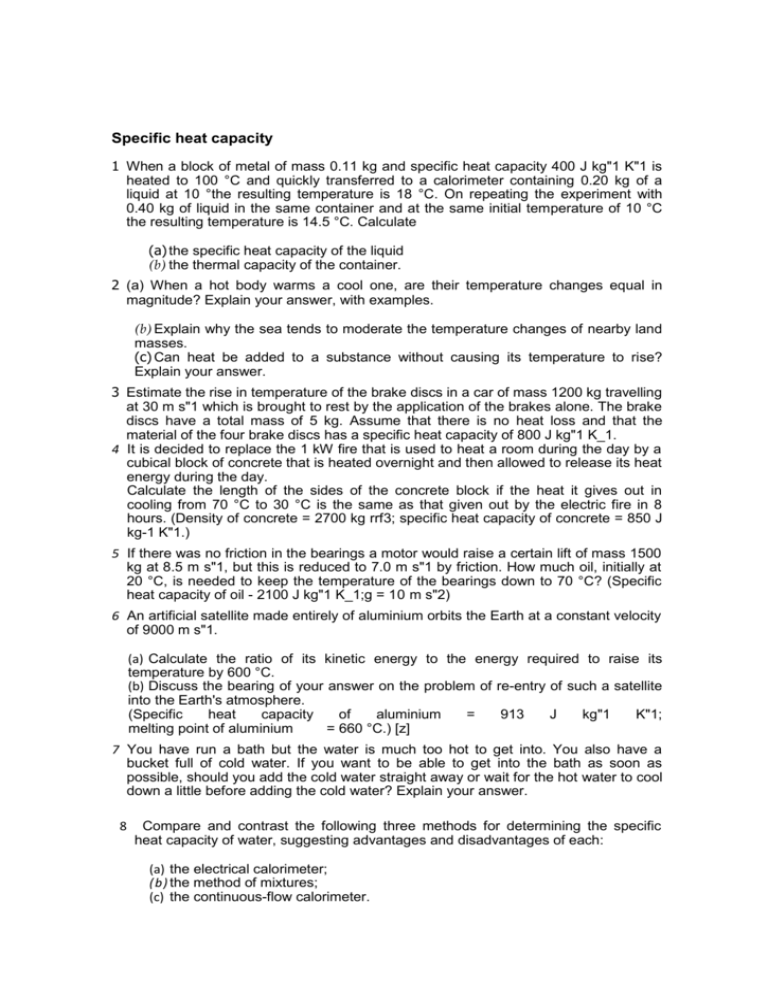
Specific heat capacity 1 When a block of metal of mass 0.11 kg and specific heat capacity 400 J kg"1 K"1 is heated to 100 °C and quickly transferred to a calorimeter containing 0.20 kg of a liquid at 10 °the resulting temperature is 18 °C. On repeating the experiment with 0.40 kg of liquid in the same container and at the same initial temperature of 10 °C the resulting temperature is 14.5 °C. Calculate (a) the specific heat capacity of the liquid (b) the thermal capacity of the container. 2 (a) When a hot body warms a cool one, are their temperature changes equal in magnitude? Explain your answer, with examples. (b) Explain why the sea tends to moderate the temperature changes of nearby land masses. (c) Can heat be added to a substance without causing its temperature to rise? Explain your answer. 3 Estimate the rise in temperature of the brake discs in a car of mass 1200 kg travelling at 30 m s"1 which is brought to rest by the application of the brakes alone. The brake discs have a total mass of 5 kg. Assume that there is no heat loss and that the material of the four brake discs has a specific heat capacity of 800 J kg"1 K_1. 4 It is decided to replace the 1 kW fire that is used to heat a room during the day by a cubical block of concrete that is heated overnight and then allowed to release its heat energy during the day. Calculate the length of the sides of the concrete block if the heat it gives out in cooling from 70 °C to 30 °C is the same as that given out by the electric fire in 8 hours. (Density of concrete = 2700 kg rrf3; specific heat capacity of concrete = 850 J kg-1 K"1.) 5 If there was no friction in the bearings a motor would raise a certain lift of mass 1500 kg at 8.5 m s"1, but this is reduced to 7.0 m s"1 by friction. How much oil, initially at 20 °C, is needed to keep the temperature of the bearings down to 70 °C? (Specific heat capacity of oil - 2100 J kg"1 K_1;g = 10 m s"2) 6 An artificial satellite made entirely of aluminium orbits the Earth at a constant velocity of 9000 m s"1. (a) Calculate the ratio of its kinetic energy to the energy required to raise its temperature by 600 °C. (b) Discuss the bearing of your answer on the problem of re-entry of such a satellite into the Earth's atmosphere. (Specific heat capacity of aluminium = 913 J kg"1 K"1; melting point of aluminium = 660 °C.) [z] 7 You have run a bath but the water is much too hot to get into. You also have a bucket full of cold water. If you want to be able to get into the bath as soon as possible, should you add the cold water straight away or wait for the hot water to cool down a little before adding the cold water? Explain your answer. 8 Compare and contrast the following three methods for determining the specific heat capacity of water, suggesting advantages and disadvantages of each: (a) the electrical calorimeter; (b) the method of mixtures; (c) the continuous-flow calorimeter. 9 A student uses the continuous-flow calorimeter to determine the specific heat capacity of water. The first experiment was performed with a flow rate of 40 g per minute and a power unit of 30 W. The steady-state readings on the two thermometers were 18.5 °C for the input water temperature and 26.5 °C for the outlet water temperature. The flow rate was adjusted to 20 g per minute and a power input of 18.25 W was found to give the same temperature difference as before. Use the results to calculate the specific heat capacity of water. 10 In a determination of the specific heat capacity of water using the continuous flow method the following readings were taken: First experiment E.m.f. = 3.05 V. Current = 6.55 A. 0.431 kg of water pass through the apparatus in 20 minutes giving a rise of temperature of 11.5 °C. Second experiment E.m.f. = 3.15 V. Current = 7.54 A. 0.524 kg of water pass through in 20 minutes and give the same temperature rise as before. Use these values to calculate the specific heat capacity of water.
